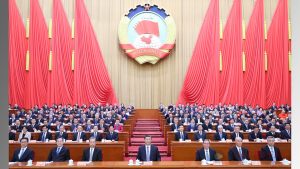
China’s New Guidelines on Displaying Names of Places in Chinese language on Maps
The recent norms of China’s Ministry of Natural Resources for displaying content in open maps has once again come in the news. It is a new irritant causing discontent for the neighbouring countries. Many see this as a practice that would further complicate China’s already existing border disputes. Chinese new norms require displaying places in bordering areas in maps published in foreign language with explanatory designations in brackets with phonetic transcription of the same in Chinese language.
China has unresolved border disputes with most of the neighbouring countries including Central Asia, Russia and Japan. This new norm of referring to names of places in Chinese language along with foreign language in brackets is likely to complicate the border disputes further. Beijing has a long history of reflecting its borders as per its own perception disrespecting sentiments of over 20 countries.
It is seen as an effort to give territorial claims to virtually all of its bordering neighbourers. Right from Spratly Island claims with the Philippines and South China Sea, it is locked in dispute with all of its neighbouring countries on territorial claims. China also has an ongoing dispute with Tajikistan which dates back to 1884. It is also claiming over 34,000 sq km of land in Kazakhstan as part of its territory.
Though there are many examples of the new norms being implemented, the city of Vladivostok attracted the attention of many critics including Western media and social media users. The new Chinese norms call for the name ‘Vladivostok’ to be supplemented with ‘Haishenwai’ in brackets on Chinese maps. This could draw Russian displeasure. Vladivostok is the largest Russian port on the Pacific Ocean and the chief cultural, economic & scientific and tourism hub of the Russian Far East.
A part of the media, particularly western, tried to project the incident as ‘Chinese claims over Vladivostok’. Some of them cited the reference of Vladivostok in two paragraphs out of more than 22 paras of the ‘new norms’ as China’s deliberate move of redefining territorial limits. They opine that Beijing would first build a perception and gradually create a psychological ground for territorial claims.
Some Russians were agitated with the reports appearing in the Western, Japanese and Ukrainian media about the renaming of Vladivostok to Haishenwai on Chinese maps. They are also tired that even the bonhomie of the friendship is not preventing Beijing from territorial aggression.
However, the Russian officials tried to downplay the Chinese act by clarifying that this rule was in effect earlier also in official cartographic publications.
But now the rules seem to have been reduced to a common practice of writing the main name in Russian followed by Chinese name in brackets. This practice has been observed in almost all unofficial maps. The Russian side further clarified that the rule is for displaying borders and toponyms for the entire perimeter of the Chinese boundary and not limited to Vladivostok.
Russian social media users could not be convinced with this official clarification.
A Russian telegram channel “Chinese threat” with more than 91,000 followers commented, “Chinese friends are, of course, our best friends. But we still have questions”. They pointed out that on ‘unofficial’ maps of Baydu, Chinese did not remove designation of Big Ussuri Island as wholly owned by China.
Despite good friendship, the Chinese do not recognize ownership of disputed Kuril Islands by Russia, designating them as ‘occupied’.” It stated, “we are friends, the Chinese must understand”.
Earlier also the issue of China’s territorial claims on Russia’s Vladivostok has been subject of public discussion and even dragged diplomats into the debate.
A video posted by the Russian Embassy in China on Weibo, the Chinese equivalent of Twitter to celebrate the 160th anniversary of Vladivostok sparked online outrage with Chinese diplomats, journalists and users referring to the city by its old name “Haishenwai”.
Historically, Vladivostok, once a part of China’s Qing dynasty, was annexed by the Russian empire in 1860 when British and French forces defeated China in the ‘Opium War – II’. Since then, the area has been administered by Russia under the capital of Primorsky Krai.
The territorial disputes were settled between both countries over three different border agreements signed in 1991, 1994 and 2004. And as per these agreements, China received hundreds of islands in the area along Argun, Amur and Ussuri Rivers. Several of these Russian areas have now been renamed and remain an integral part of China.
Chinese and Russian Foreign Ministers also signed an additional treaty in 2008 known as the Sino-Russian Border Line Agreement, which marked the mutual recognition and acceptance of the demarcation.















Comments